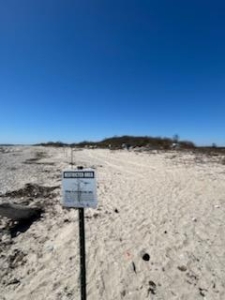September is here and the 2025 shorebird season on Fishers Island has officially wrapped up. We have now seen all of our Piping Plover chicks fledge and move on, and the protective fencing that marked our nesting areas has been taken down for the year. Our Least Terns also completed their nesting season, contributing to another busy summer of coastal bird monitoring.
This season was a success in that fledglings were produced at multiple sites, but overall productivity for Piping Plovers averaged 1.4 fledglings per pair, which is lower than the 2.0 fledglings per pair recorded in 2024. Even with protective measures in place, success rates can shift from year to year due to a combination of natural factors and management challenges. Importantly, Fishers Island’s productivity remains higher than both New York State and U.S. averages. In our region, a rate of 1.2 to 1.5 fledglings per pair is considered stable or above average, which means our beaches continue to serve as an important stronghold for plovers. For more on piping plover conservation in New York, visit the NYSDEC Piping Plover page.
2025 Results by Site
At one of our secluded sites near Isabella beach (Secret beach), one plover pair nested and produced four eggs. Three hatched and one chick fledged.
Big Club beach, which was active last year, had no plover activity in 2025.
East beach had one pair that laid four eggs, but none hatched.
Eighth Hole continued to be one of the most productive sites, with one pair attempting two nests. Four chicks hatched there and three fledged.
Stony beach remained inactive.
South beach had, two pairs nested and three chicks fledged, though productivity per pair was lower than last year.
Altogether in 2025, Fishers Island hosted five plover pairs across its beaches. At least twelve eggs were laid, ten chicks hatched, and seven fledged.
The Role of Fencing and Management
Fencing played a key role in protecting nesting areas from disturbance. By keeping people and dogs away from sensitive stretches of beach, fencing gave both plovers and terns a chance to incubate eggs and raise their young with less interference. At the same time, fencing can sometimes bring unintended challenges. Protective structures may draw attention to nests and even attract predators. While fencing is necessary for protection, these subtle dynamics may help explain why plover productivity was lower this year than in 2024. With the season complete, all fencing has now been removed until next year.
Looking Back at 2024
The 2024 season produced stronger results overall for plovers.
At Secret beach, two pairs attempted nesting but outcomes were unknown.
Big Club beach hosted one pair that fledged one chick.
East beach was inactive.
Eighth Hole was the standout, with one pair successfully raising all four of its chicks to fledging.
Stony beach was inactive.
South beach had one pair that fledged three chicks.
In total, 2024 produced five plover pairs, twelve eggs, and eight fledged chicks, for an overall productivity of 2.0 fledglings per pair.
Least Terns also nested successfully in 2024, with multiple pairs using beach habitat and producing young.
Takeaways
Comparing the two years highlights both the successes and challenges of shorebird conservation. Eighth Hole and South beach remained the most productive plover sites, though their outcomes shifted slightly between years. Big Club beach was active in 2024 but not in 2025, while East beach showed activity this year but no successful hatching.
Looking Ahead
By late July and August, both Piping Plovers and Least Terns begin leaving their nesting beaches, with most gone by early September as they head to wintering grounds further south. With the season now closed, we turn our attention to preparing for next year.
Next year will mark our third season working in partnership with the New York State Department of Environmental Conservation. We plan to continue improving our program by strengthening monitoring, refining protection measures, and finding new ways to involve the community in conservation!
Stay tuned for next season as we continue to grow this effort, with the shared goal of protecting shorebirds and the habitats they depend on.
If you have questions or want to get involved, feel free to reach out at annarwfic@gmail.com.
Featured photo by Larry Auger